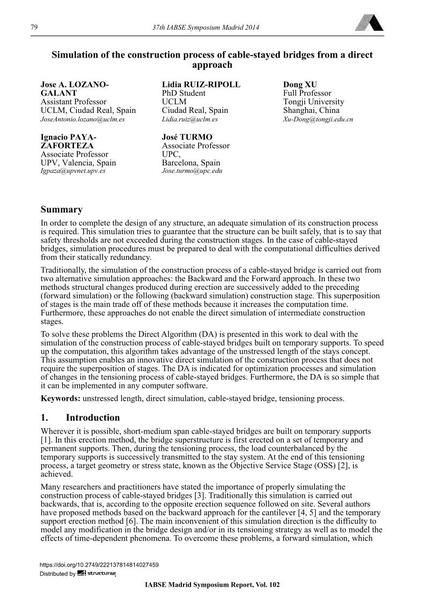Simulation of the construction process of cable-stayed bridges from a direct approach

|
|
|||||||||||
Détails bibliographiques
| Auteur(s): |
Jose A. Lozano-Galant
Lidia Ruiz-Ripoll Dong Xu Ignacio Payá-Zaforteza José Turmo |
||||
|---|---|---|---|---|---|
| Médium: | papier de conférence | ||||
| Langue(s): | anglais | ||||
| Conférence: | IABSE Symposium: Engineering for Progress, Nature and People, Madrid, Spain, 3-5 September 2014 | ||||
| Publié dans: | IABSE Symposium Madrid 2014 | ||||
|
|||||
| Page(s): | 79-86 | ||||
| Nombre total de pages (du PDF): | 8 | ||||
| Année: | 2014 | ||||
| DOI: | 10.2749/222137814814027459 | ||||
| Abstrait: |
In order to complete the design of any structure, an adequate simulation of its construction process is required. This simulation tries to guarantee that the structure can be built safely, that is to say that safety thresholds are not exceeded during the construction stages. In the case of cable-stayed bridges, simulation procedures must be prepared to deal with the computational difficulties derived from their statically redundancy. Traditionally, the simulation of the construction process of a cable-stayed bridge is carried out from two alternative simulation approaches: the Backward and the Forward approach. In these two methods structural changes produced during erection are successively added to the preceding (forward simulation) or the following (backward simulation) construction stage. This superposition of stages is the main trade off of these methods because it increases the computation time. Furthermore, these approaches do not enable the direct simulation of intermediate construction stages. To solve these problems the Direct Algorithm (DA) is presented in this work to deal with the simulation of the construction process of cable-stayed bridges built on temporary supports. To speed up the computation, this algorithm takes advantage of the unstressed length of the stays concept. This assumption enables an innovative direct simulation of the construction process that does not require the superposition of stages. The DA is indicated for optimization processes and simulation of changes in the tensioning process of cable-stayed bridges. Furthermore, the DA is so simple that it can be implemented in any computer software. |
||||
| Mots-clé: |
Pont à haubans
|
||||

